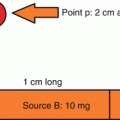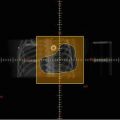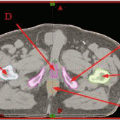(1)
University of Miami Sylvester Cancer Center, Miami, Florida, USA
13.1 Imaging Modalities (Questions)
Quiz 1 (Level 2)
1.
A transverse tomography unit consists of:
A.
A diagnostic x-ray tube and a film cassette that rotates simultaneously with the x-ray tube
B.
A diagnostic x-ray tube and stationary circular array of detectors
C.
A couch or table that moves in while the gantry rotates
D.
A fixed diagnostic x-ray tube and movable circular array of detector
2.
The difference between conventional tomography and transverse tomography is:
A.
I, II, and III only
B.
I and III only
C.
II and IV only
D.
IV only
E.
All are correct
I.
The orientation of the plane in focus.
II.
A conventional tomography image is parallel to the long axis of the patient.
III.
Transverse tomogram provides a cross-sectional image perpendicular to the body axis.
IV.
Transverse tomogram provides a cross-sectional image lateral to the body axis.
3.
The main disadvantage of conventional transverse tomography is:
A.
Its cost
B.
The speed at which it generates slices
C.
The presence of blurred images resulting from structures outside the plane of interest
D.
Inaccurate delineation of surface contour, internal structures, and target volume
4.
Which of the following modalities can be used to accurately delineate target volumes and normal structures?
A.
I, II, and III only
B.
I and III only
C.
II and IV only
D.
IV only
E.
All are correct
I.
Magnetic resonance imaging (MRI)
II.
Single-photon emission computed tomography (SPECT)
III.
Positron emission tomography (PET)
IV.
Ultrasound (US)
5.
The most commonly used imaging modalities in radiation oncology are:
A.
I, II, and III only
B.
I, III, and IV only
C.
II and IV only
D.
IV only
E.
All are correct
I.
Magnetic resonance imaging (MRI)
II.
Ultrasound (US)
III.
Computed tomography (CT)
IV.
Positron emission tomography (PET)
6.
Which of the following is/are true about CT:
A.
I, II, and III only
B.
I and III only
C.
II and IV only
D.
IV only
E.
All are correct
I.
A CT image is reconstructed from a matrix of relative linear attenuation coefficients.
II.
A single CT image typically consists of 512 × 512 pixels.
III.
Each pixels measure the relative linear attenuation coefficient of the tissue.
IV.
A CT image can be used to correct for tissue inhomogeneities.
7.
Digital reconstructed radiographs (DRRs) are reconstructed images in planes other than:
A.
I, II, and III only
B.
I and III only
C.
II and IV only
D.
IV only
E.
All are correct
I.
Sagittal
II.
Coronal
III.
Oblique
IV.
Transverse
8.
Which of the following CT slice thickness is best to obtain high-quality DRRs?
A.
2–10 mm
B.
10 mm to 1 cm
C.
1–1.5 cm
D.
>2 cm
9.
Which of the following is not correct about spiral or helical CT?
A.
Allows for continuous rotation of the x-ray tube as the patient is translated through the scanner aperture
B.
Reduces the overall scanning time
C.
Allows for the acquisition of a large number of thin slices required for high-quality CT images and the DRRs
D.
Increases the overall scanning time due to numbers of reconstruction images
10.
For radiation therapy treatment planning purposes:
A.
I, II, and III only
B.
I and III only
C.
II and IV only
D.
IV only
E.
All are correct
I.
The CT couch must be flat.
II.
The CT couch could be of any type.
III.
The patient must be setup in the CT in the same position as for actual treatment.
IV.
A radiology CT scan setup can be used.
11.
CT images can be processed to generate DRRs in which planes:
A.
I, II, and III only
B.
I and III only
C.
II and IV only
D.
IV only
E.
All are correct
I.
Sagittal.
II.
Coronal.
III.
Oblique.
IV.
It cannot create oblique views.
12.
A CT simulator is:
A.
A CT scanner equipped with some additional hardware such as laser localizers, image registration devices, and a flat couch
B.
A CT scanner used in a radiology department
C.
A CT scanner that simulates the HDR room
D.
A linac used to CT patients
13.
In general, MRI is considered superior to CT for:
A.
Contrast studies
B.
Calcifications structures
C.
Bony structures
D.
Soft tissue discrimination
14.
The most basic difference between CT and MRI is:
A.
CT is related to electron density and atomic number, while MRI shows proton density distribution.
B.
CT is related to proton density distribution, while MRI shows electron density and atomic number.
C.
There is not any basic difference between CT and MRI.
D.
CT spatial resolution is better than MRI.
15.
MRI advantages include:
A.
I, II, and III only
B.
I and III only
C.
II and IV only
D.
IV only
E.
All are correct
I.
Soft tissue structures contrast.
II.
Can be used to directly generate scans in axial, sagittal, coronal, or oblique planes.
III.
No exposure to radiation.
IV.
It is not susceptible to artifacts.
16.
Which of the following modalities provides the best geometric accuracy?
A.
Magnetic resonance imaging (MRI)
B.
Ultrasound (US)
C.
Positron emission tomography (PET)
D.
Computed tomography (CT)
17.
The major advantage of CT in radiation therapy treatment planning is:
A.
3D imaging.
B.
Each voxel can be mapped to a specific electron density.
C.
Histograms can be generated.
D.
Contouring can be done easily.
18.
A CT image is made of:
A.
I, II, and III only
B.
I and III only
C.
II and IV only
D.
IV only
E.
All are correct
I.
Pixels
II.
Voxels
III.
Field of view (FOV)
IV.
DICOM
19.
Image contrast can be achieved by:
A.
Selecting the appropriate voxel, pixel, and matrix
B.
Reconstruction of the CT image
C.
Leveling and windowing the CT image
D.
Selecting the Hounsfield number (H)
20.
When windowing and leveling a CT image:
A.
I, II, and III only
B.
I and III only
C.
II and IV only
D.
IV only
E.
All are correct
I.
The operator selects a part of the gray scale to work with.
II.
The operator selects the window width.
III.
The operator selects the level of gray scale to visualize.
IV.
The organ of interest must be taken in consideration.
21.
When selecting a window on a CT image:
A.
I, II, and III only
B.
I and III only
C.
II and IV only
D.
IV only
E.
All are correct
I.
Anything above the window level would be white.
II.
Anything below the window level would be black.
III.
The contrast will be affected.
IV.
Narrow window will have high contrast.
22.
If the size of the detectors in the CT scanner are reduced and the number of pixels in the image is increased, what parameter is affected?
A.
Contrast
B.
Spatial resolution
C.
Artifacts
D.
Noise
23.
Noise on a CT image or film is the:
A.
Variation on the pixel readings
B.
Incorrect leveling and windowing the CT image
C.
Thickness of CT image
D.
Incorrect field of view (FOV)
24.
Field of view refers to:
A.
The size of a pixel
B.
A matrix
C.
The diameter of the image reconstructed
D.
The volume of a voxel
25.
When converting attenuation readings from a detector to a digital image in a CT:
A.
A reconstruction algorithm is employed.
B.
The field of view is set.
C.
A radiographic film is developed.
D.
Window width is adjusted.
26.
Hounsfield numbers range from:
A.
1 to 100
B.
–100 to +500
C.
–1,000 to +3,000
D.
0 to 1,000
27.
The Hounsfield number (H):
A.
I, II, and III only
B.
I and III only
C.
II and IV only
D.
IV only
E.
All are correct
I.
Is related to a CT number
II.
Is related to linear attenuation coefficients of different tissues
III.
Represents a change of percentage in the attenuation coefficient of water
IV.
Is related to homogeneity coefficient
28.
The correct formula of Hounsfield number is:
A.
H = (μ tissue – μ water)/μ tissue × 1,000
B.
H = 1,000 – μ water/μ tissue
C.
H = (μ tissue – μ water)/μ water × 1,000
D.
H = 1,000 – μ water/μ tissue × 1,000
29.
Match the following Hounsfield number with its corresponding organ or tissue.
A. | Air | I. | –1,000 |
B. | Water | II. | +1,000 |
C. | Bone | III. | –100 |
D. | Fat | IV. | 0 |
E. | Muscle | V. | +40 |
30.
Some common considerations in obtaining treatment planning CT scans are:
A.
I, II, and III only
B.
I and III only
C.
II and IV only
D.
IV only
E.
All are correct
I.
A flat table top should be used.
II.
A large diameter CT aperture (or bore) can be used to accommodate unusual arm positions or body parts.
III.
Image artifacts should be avoided.
IV.
Radiopaque markers should be used for external contour landmarks.
31.
Which of the following organs has the lowest Hounsfield unit:
A.
Fat
B.
Lungs
C.
Water
D.
Muscle
32.
A CT number assigned to a pixel represents:
A.
The average linear attenuation coefficient of tissue in the voxel
B.
The electron density in the voxel
C.
The atomic number of tissue in the voxel
D.
The atomic mass of tissue in the voxel
33.
Disadvantages of MRI compared to CT include:
A.
I, II, and III only
B.
I and III only
C.
II and IV only
D.
IV only
E.
All are correct
I.
MRI provides lower spatial resolution.
II.
Inability to image bone or calcifications.
III.
Longer scan acquisition time.
IV.
Technical difficulties due to small bore of the magnet and magnetic interference with metallic objects.
34.
Which of the following is/are true about MRI:
A.
I, II, and III only
B.
I and III only
C.
II and IV only
D.
IV only
E.
All are correct
I.
It involves a phenomenon known as nuclear magnetic resonance.
II.
It involves radiofrequency (RF) signal.
III.
It involves nuclei that intrinsically possess spinning motion.
IV.
It is most distinguished in nuclei with an odd number of protons.
Quiz 2 (Level 3)
1.
Which of the following is the primary element used for MRI imaging that produces signals of sufficient strength?
A.
23Na
B.
13C
C.
31P
D.
Hydrogen nuclei
2.
Which of the following particles possess(es) properties of spin?
A.
I, II, and III only
B.
I and III only
C.
II and IV only
D.
IV only
E.
All are correct
I.
Photon
II.
Electron
III.
Positron
IV.
Proton
3.
Which of the following nuclei has an intrinsic magnetic moment and angular momentum?
A.
Isotopes containing an even number of protons and/or even number of neutrons
B.
Isotopes containing an odd number of protons and/or odd number of neutrons
C.
Isotopes containing an even number of protons and/or odd number of neutrons
D.
Isotopes of any classification
4.
Magnetic fields:
A.
I, II, and III only
B.
I and III only
C.
II and IV only
D.
IV only
E.
All are correct
I.
Create a change in long axes spin direction of the nuclei (hydrogen)
II.
Cause nuclei (hydrogen) to align their spin axes along the external magnetic field (H)
III.
Cause nuclei (hydrogen) to orbit around the external magnetic field (H)
IV.
Cause nuclei (hydrogen) to be deflected around the radiofrequency field in the transverse direction
5.
The radiofrequency field is applied?
A.
Horizontal to magnetic field
B.
Perpendicular to magnetic field
C.
Longitudinal to magnetic field
D.
Same direction as magnetic field
6.
A magnetic dipole moment takes place:
A.
When charged particles relax
B.
When spinning charged particles create a magnetic field from east to west poles
C.
When spinning charged particles create a magnetic field from south to north poles
D.
When a second radiofrequency field is applied to the magnetic field
7.
T2 relaxation is:
A.
The time it takes the nuclei to return to the original longitudinal direction of the magnetic field
B.
The time it takes the nuclei to change spin direction
C.
The time it takes the nuclei to deflect from the longitudinal plane to transverse plane
D.
The time it takes the nuclei to relax from transverse direction
8.
Nuclear magnetic resonance signal is induced:
A.
When the south and north poles are aligned
B.
When proton spin is increased
C.
When the radiofrequency field is turned on
D.
When relaxation occurs
9.
Localization of protons in MRI in a 3D space is achieved by?
A.
RF gradient produced by magnetic field in two orthogonal planes
B.
Applying magnetic field gradients produced by gradient RF coils in three orthogonal planes
C.
T1 and T2 relaxation
D.
Magnetic field gradients produced by gradient RF in two orthogonal planes
10.
Which of the following MRI statements is/are true:
A.
I, II, and III only
B.
I and III only
C.
II and IV only
D.
IV only
E.
All are correct
I.
A body slice is imaged by applying field gradient along the axis of the slice and selecting a frequency range for readout.
II.
The strength of the field gradient determines the thickness of the slice.
III.
The greater the gradient, the thinner the slice.
IV.
Most MR imaging uses a spin echo technique.
11.
MRI image contrast can be affected by?
A.
Adjusting T1 and T2 relaxation
B.
Adjusting window and leveling
C.
Adjusting echo time (TE) and repetition time (TR)
D.
Adjusting kVp and mA
12.
Which of the following combinations produces an MRI T1-weighted image?
A.
A long TR and short TE
B.
A long TR and a long TE
C.
A short TR and a short TE
D.
A short TR and a long TE
13.
Get Clinical Tree app for offline access

Which of the following units and ranges is used to measure the MRI magnetic field strength?







